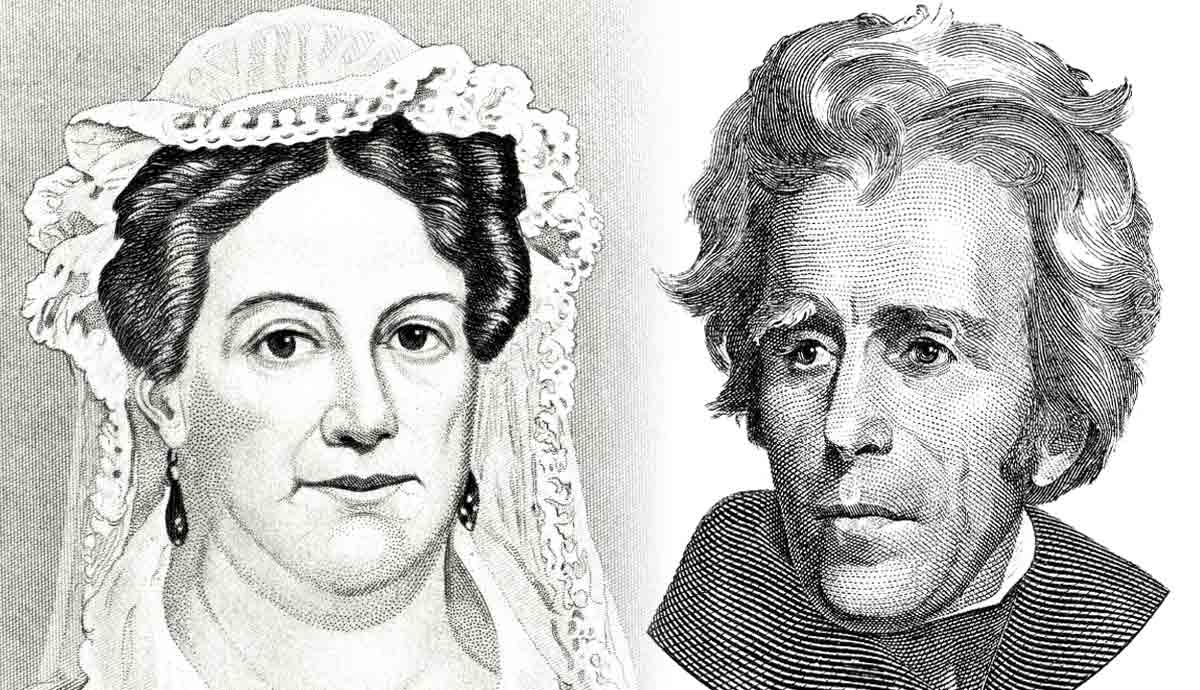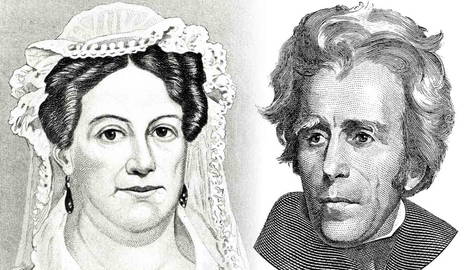
During the 1828 presidential election, Democrat Andrew Jackson’s political enemies accused Rachel Jackson of being a bigamist and adulterer. Jackson, ever the fighter, defended his wife’s honor. But he couldn’t stop the public mudslinging that came to characterize the election. Andrew and Rachel were a true love story, but the marriage was indeed scandalous. With their past mistake brought to light, the election proved to be more than Rachel could bear. Republicans ignited a political snowball that put Rachel in her grave and an angry Jackson in the White House.
Rachel Marries Lewis Robards

At seventeen years old, Rachel Donelson was a vivacious young woman who loved to dance and ride horses at her Nashville, Tennessee home. When she married Lewis Robards in 1787, she could not have known that he was a jealous, unpleasant man or that the marriage would gain national attention decades later. Historians have described Robards as despicable, childish, and abusive. Their marriage was an unhappy union, and eventually, the couple separated.
Rachel and Robards attempted to reconcile. She moved back into her mother’s home, and later Robards did as well. At that time, a young and ambitious Andrew Jackson was boarding at Mrs. Donelson’s house. The jealous Robards disliked Jackson and confronted him on at least one occasion. Eventually, an angry Robards left Nashville, loudly boasting that he would never return. Divorces were rare, and state laws were not wholly unified yet. The process was regionally specific, which would later cause confusion. Nonetheless, Rachel heard that Robards was seeking a divorce. Relieved by the news of a forthcoming divorce and Robards departure, Rachel made plans to move to Bayou Pierre, Spanish territory, to live with friends.
Rachel was part of a group that headed south, with Andrew Jackson serving as protective escort. She did not know that Robards had only gained permission to file for a divorce and that he had not actually obtained one. At the time, Rachel believed herself divorced. When she fell in love with Andrew Jackson and decided to marry several months later, the couple naively saw no obstacle in their way. That mistake would torment Rachel in the coming years and force Jackson to defend her honor.
The Scandalous Marriage of Andrew and Rachel Jackson

The exact marriage date of Andrew and Rachel Jackson is unknown, but it is believed to have taken place in February, 1791 in Natchez. No records exist of the marriage, and little is known about it. The officiant of the marriage is also unknown. The wedding would have likely been done discreetly. It is known that the Jacksons lived as husband and wife for two years before learning that Rachel was still married to Lewis Robards. Since she was still married to Robards, her marriage to Andrew was considered void, and Robards was able to openly accuse her of bigamy.
Divorce Came Late

On December 20, 1790, the Virginia Legislature had granted Robards permission to pursue a divorce, in something that was called an enabling act. However, the laws differed by state and territory as the western United States was still expanding. Thus, where Jackson had studied law in North Carolina, the enabling act itself was considered a divorce. Because of this, Rachel and Andrew believed the enabling act granted the divorce, thus influencing their decision to marry in Natchez shortly afterward.
However, the divorce between Robards and Rachel was not actually granted until September 27, 1793, on the grounds of adultery. Rachel Jackson had been married to two men simultaneously, albeit accidentally, for two years. Nonetheless, once the divorce was final, Andrew and Rachel immediately remarried.
Andrew & Rachel’s Relationship

Rachel and Andrew were a loving and devoted couple. They did not have any children of their own, but they adopted and raised several children including nephews, a niece, and a Native American boy named Lyncoya. They were affectionate and supportive partners. Andrew relied on Rachel to run their plantation, The Hermitage, while he was away. They were often apart due to Jackson’s military and political career, but they wrote letters to each other frequently. These letters reveal a tender relationship characterized with respect and honesty. They often addressed each other as, “My Love,” or “My Dearest.”
Andrew was compelled to defend Rachel’s honor several times during their marriage. In 1806, a disagreement over a horse bet led an attorney, Charles Dickinson, to slander Rachel. Dickinson questioned Rachel’s honor, publicly scrutinizing her alleged bigamy. He later apologized, claiming to have been drunk. Even so, Andrew was enraged and called for a duel. Dickinson fired first. Andrew was hit with a bullet near the heart. Despite the wound, Jackson coolly fired at Dickinson, hitting him in the stomach. Dickinson died shortly afterward. Rachel’s virtue was protected.
Andrew and Rachel were well known among Nashville society. He became a prominent lawyer and famous as the general who won the Battle of New Orleans in the War of 1812. That popularity boosted him into politics, where he became a senator and eventually president.
Rachel, on the other hand, was a country girl. She was tanned and stout. She liked to smoke a pipe. She was very different from the political wives with whom she often intermingled. Nonetheless, Andrew was notoriously smitten with Rachel. They were married for over thirty years and were remembered in history for their undying love for each other.
The Mudslinging of the 1828 Election

The presidential campaign of 1828 is considered the first mudslinging campaign in American history. John Quincy Adams’s supporters printed pamphlets and wrote newspaper columns intending to portray Andrew and Rachel Jackson as morally tainted and unsuitable to lead the country. Jackson’s team fought back. Highlighting his military victory in the War of 1812 at the Battle of New Orleans, they portrayed him as a war hero comparable to George Washington. They ticketed him as the average American’s president, a self-made Western man with humble origins. At the time, many Americans felt that the politicians in Washington DC were elitists who did not concern themselves with average Americans. Jackson was an anti-elitist and ignited the Populist movement to represent the working-class people. They called out Adams for his wealth and privilege, a New England aristocrat far removed from the realities of average Americans.

As the campaign progressed, the mudslinging intensified. Jackson was presented as an uncouth Western man who seduced a young bride, persuaded her to abandon Robards, and further sullied her reputation by living in sin. In this way, Rachel was not spared the mudslinging. She was called a bigamist and portrayed as an immoral adulteress. Journalists sensationalized the story. Adams’s supporters claimed that if the Jackson’s would disregard the sanctity of marriage, they were surely too unscrupulous to run the country.
The onslaught lasted months and began to take a toll on Rachel’s health. Embarrassed by the national attention, she fell into a depression. Jackson’s presidential victory did not ease her distress. She dreaded associating with the political circle in Washington DC. She would not have to, though. Rachel died of a heart attack shortly after Jackson was declared the winner. Andrew never forgave his political enemies and was adamant that the campaign stress caused her death.
The Legacy of Their Love Story

Rachel Jackson suffered from heart ailments. The stress of the election had taken a toll on her health. In late December she had a heart attack and died a few days later at their Hermitage home. She was sixty-one years old. Andrew, frantic with fear of losing her, held her in his arms until she passed. Her funeral was held on Christmas Eve. She was buried in her garden, wearing her white inaugural dress. The Nashville mayor asked that businesses be closed in her honor, and over 10,000 mourners attended her funeral. A devastated Andrew was distraught and gaunt. He collapsed in grief at the foot of her grave, heartbroken.
Andrew would later have his presidency sullied for corruption, putting political supporters in government positions, and the Indian Removal Act. The Trail of Tears forced thousands of Native Americans to relocate and walk hundreds of miles in the winter without appropriate clothing or adequate food rations. The Age of Jackson saw the opening of the West in Manifest Destiny and extended voting rights to all white men, yet women, Black Americans, and Native Americans had few rights.
Though his enemies tried, they could not taint Andrew’s love of Rachel. Faced with frequent personal and political attacks on their marriage, Andrew and Rachel Jackson remain one of America’s most successful unions. Rachel and Andrew Jackson are one of American history’s true love stories. They are remembered for their remarkable marriage and friendship. They were a love match whose dedication to each other was strong enough to weather years of public gossip and slander. They were a couple who danced together, confided their worries to each other, and shielded one another. Although their marriage was scandalous, their love story was unwavering.
References
Basch, Norma. (December, 1993). “Marriage, morals, and politics in the election of 1828.” The Journal of American History 80 (3), 890-918.
Bertram, Wyatt-Brown. (Spring, 1997). “Andrew Jackson’s honor.” Journal of the Early Republic 17 (1). 1-36.
Owsley, Harriet Chappell. (Winter 1977). “The marriages of Rachel Donelson.” Tennessee Historical Quarterly 36 (4), 479-492.
The Hermitage. (2024). Thehermitage.com. Retrieved August 15, 2024.










